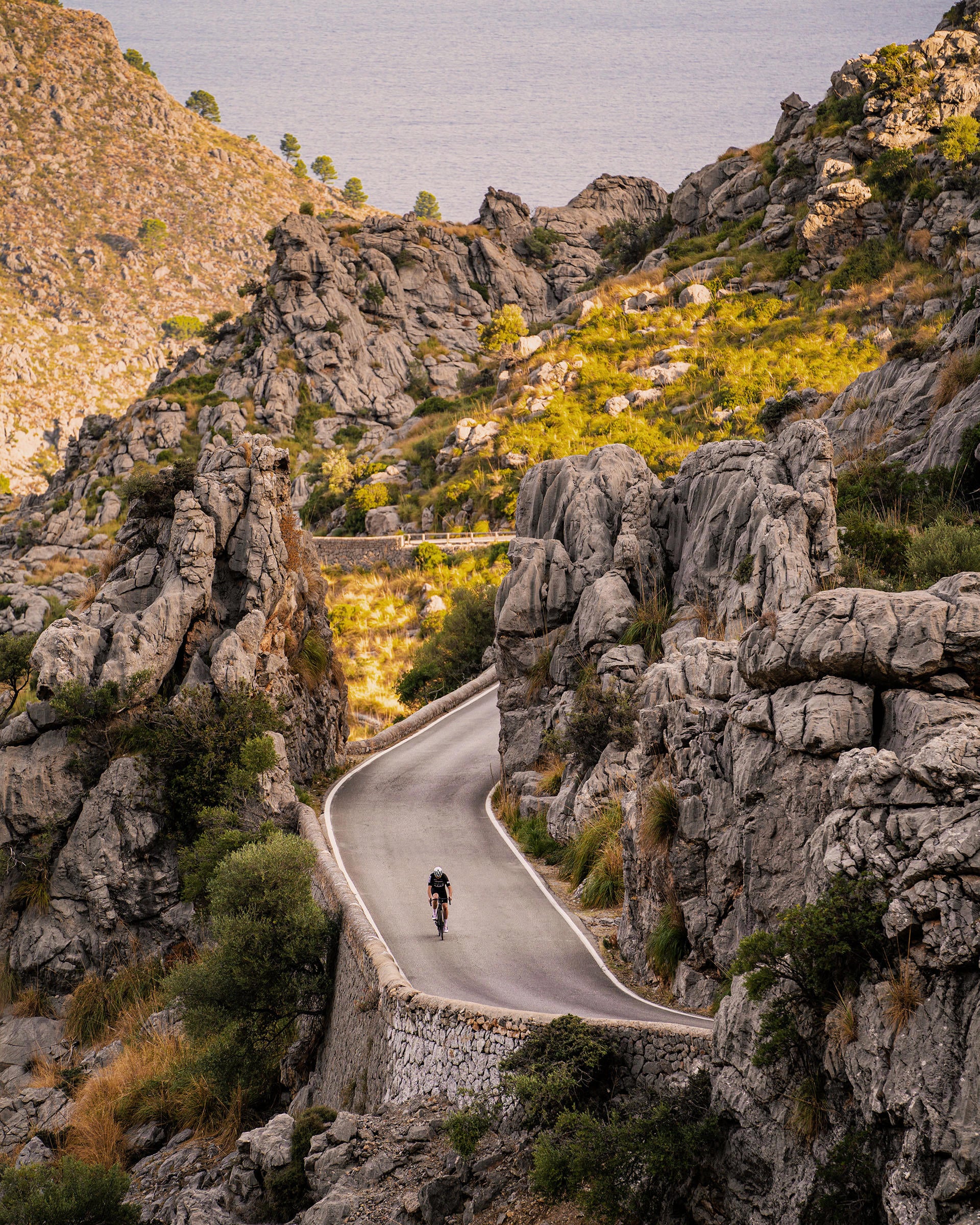The Only Way Up Is Down
The Sa Calobra serpentine winds and undulates along the Spanish isle's picturesque, seemingly lunar mountainside. Over these stunning 10 km, riders gain over 600 m / 2,000 ft of elevation gain as the road travels inland through the Tramuntana mountain range and into the clouds.
Sa Calobra village, on the shore, is reachable by two methods: by sea or by descending to it from the top of the mountain. However, this unique location of Sa Calobra, isolated from any other land and only accessible by crossing Coll del Reis, means that you must descend to the bottom of the col before taking on the challenge of climbing it. Simply put, the only way up is down.
Due to our schedule in Mallorca, booked with coffee rides around Palma and time spent with the community, we needed to efficiently plan our journey to the famed climb. While temperatures in Mallorca are mild almost all year long, we wanted to beat the heat and the crowds. Sa Calobra is a popular destination for cyclists and tourists alike. By 10:00am, the road is typically packed with cyclists, cars, vans, tour buses, and what have you, all vying to capture a glimpse of the mountainside's stunning vistas and iconic scenery.
From Palma de Mallorca to Sa Calobra
Since we decided to beat the sun (and light), we drove from Palma to the base of the climb. On the eve prior, we secured a sprinter van that could fit the team and the bikes, and we enjoyed an authentic seafood dinner on Palma's coast at Restaurante La Parada del Mar. We had spent days seeking some genuine local catch and finally found it at the fish market + restaurant on the outskirts of town, near the harbor. Immediately as you walk into La Parada del Mar, you're met with a selection of the day's local catch, and the host consults you on which fish you'd like to enjoy. After hand-selecting your meal, the staff guides you to your table, where you're served a delicious selection of fish, vegetables, and french fries. For dessert, we couldn't resist the pastel de zanahoria..
The excitement and anticipation of climbing one of Europe's most revered roadways were palpable. We still didn't know exactly what to expect. Later that evening, but not too much later, we scoured the streets of Palma's Santa Catalina neighborhood for a parking spot, which became exceedingly challenging on a Sunday night. Finally, after enough laps around the area, we took a chance to park in front of a construction site. After all, we would depart in less than 6 hours. We needed to prepare our gear and get to bed. The lights went out around 11:00 pm.
The bells started ringing at 4:30am. The first workout of the day was to churn the crank not of our bikes but of our Comandante coffee grinder and enjoy the day's first brew with half-opened eyes. Alex from Berlin was slow to awaken, even though a grand adventure awaited. Finally, he emerged from the darkness of his room with squinting eyes. We loaded up the Mercedes Metris van and gingerly finagled our bikes with precision. It felt like the only audible movement in the entire neighborhood was our quiet murmuring as we clamored in and ventured off into the darkness.
The streets were desolate on Monday morning at 5:00am. As a native New Yorker accustomed to the constant bustle of the city, I still can't help but notice the serenity of European towns and cities between midnight and 8:00 am. After 30 minutes of driving along straight, flat roads, decelerated only by traffic circles, our route altered dramatically as we ascended into the winding, technical roads of the Tramuntana Mountain Range. I was in and out of sleep in the backseat but kept reminding myself that the drive would be much scarier had we seen the unfathomable drops off the cliff sides we were driving along.
From Palma, we ventured off towards the Ma-10, a road that traverses Mallorca's northern coastline for 110km. It is considered one of the most scenic roads in all of Europe and is regularly featured in both cycling and automotive advertising. I could feel the altitude gain as we ventured further into the mountains and caught momentary glimpses of the twinkling lights of small towns beyond in the distance, at sea level.
As I transitioned in and out of sleep, my eyes opened, and I could see the road sign for Sa Calobra whizz by. Our van made a swooping left-hand turn. Advertisements for road bike rentals and cycling tours flashed, and I knew we were close. The next road sign denoted that Sa Calabra was 12 km down the road. The night sky was so dark that I could barely make out my surroundings. I was grateful we couldn't see the landscape as the van meandered through tight twists and turns. We were presumably on the edge of a massive cliffside.
After a few minutes, I was confident we had reached the tie knot: a precisely engineered 270º spiral bridge turn that sits just below the climb's summit. The tie knot is renowned globally for its engineering and scenic beauty, and to arrive here from the base of the climb is in and of itself an impressive achievement.
We spent the next 45 minutes gingerly negotiating the whopping 26 hairpins turns that contribute to the allure of Sa Calobra. As we neared the base of the climb, I rolled the window down and was surprised at how quiet and still the setting seemed. Aside from the faint chiming of goat bells, there was no sign of human life. The early drive-out was well worth it.
At last, we had reached the end of the road. I pulled my bike out of the trunk and hopped on to spin the legs a bit. Unfortunately, a makeshift gate prevented our van from driving to the port village. Upon arrival, I was surprised to learn that no one actually lived there, and as I pedaled down the sea, there wasn't a soul in sight or sound to be heard. Today's Sa Calobra village comprises a few restaurants and gift shops. But, at this hour of the day, the only thing to do in Sa Calobra is to pedal up one of the world's most revered climbs. Which is precisely what we set out to do.
The View from the Top
The opening kilometers of the climb were nothing out of the ordinary besides the clanging of goat bells. We couldn't see the goats. We could only hear them. Finally, after about 15 minutes of pedaling, we passed through the famous rock arch, Penyal del Cavall Bernat, and stopped for a quick rest and a gel at the roadside. The sky was just beginning to turn blue as the sun rose from the horizon. At last, we encountered the first human on our journey: the sanitation worker who came to collect the garbage from a small pale at the rest point.
We rode the next 9 km at a steady pace to enjoy the expansive views. The landscape reminded me of a scene out of the Flintstones. Sa Calobra's gradient is gentle, at an average of 7%, with a maximum steepness of 12%. At no point did the climb feel overly taxing. You can really lose yourself in the natural beauty of this climb. Aside from peering down at the ride computer, it's difficult to know how long you've been riding and far you have to go.
Turn after turn, the tie knot felt closer, and the sea drew farther away. Eventually, after enough hairpins, I lost track of exactly how many, and we reached the tie knot. The sun seemed to rise directly through the tunnel created by the tie knot. So I wasn't surprised to see a goat grazing within the turn of the tie knot. As we cruised through the ribbon, it was a 50-meter straight shot to the top of the climb through a mini trench. I stopped to snap a pic at the sign, "Coll dels Reis 682 m).
The view was unforgettable: we arrived between sea and sky. The Mediterranean Sea glistened below in the distance, and to the South, the Tramuntana Mountains, notably Mallorca's highest peak, Puig Major, towered above us.
After enjoying the views, the sunrise, and a snack, It was still only 7:00am. So, without thinking about it too much, I turned around and descended to the bottom of the climb to take upon Sa Calobra again.
I didn't waste time and began my nearly hour-long journey back up to the tie knot. Goat bells continued to cling and clang in the distance. With the sun now above the mountains, the air was warm, and all of the prehistoric features across the landscape were fully visible. After an hour of steady pedaling, I made my second approach to the tie knot. A man was piloting a small drone, undoubtedly taking in some stunning views. The weather couldn't have been more inviting.
This time, I ascended to the top and made my way through fast, twisting roads to the main road. At long last, a few cyclists began trickling onto the Coll del Reis to make their way down to the Sa Calobra village. Good on them for beating the crowds. At around 8:30 am, I arrived at the beginning of Coll del Reis. There were a few gift stands, but still, no one to operate them. I could only imagine the crowds and tour buses soon descending upon this exquisite landscape.
With the bikes loaded back into the van, we set off for breakfast in Soller. The invisible features peering at us in the darkness on our journey to Sa Calobra were now entirely in view. As our van careened along the Ma-10, the surreal sense of reality lingered within me, and I felt a great sense of accomplishment for having one of cycling's most revered climbs not once but twice, all to myself.












